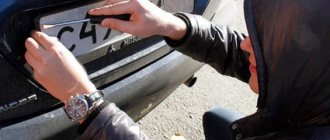Clothes theft is a secret form of taking someone else's property, one of the most common illegal acts.
Don't miss the return deadlines - otherwise it will be too late. It is better to check the information with a specialist.
You can almost always return an item!
The main thing is to know the procedure and use the law correctly. Get information for free from lawyers via chat (bottom right ↘️)
In order for an act to be recognized as theft, it must satisfy the following criteria:
- it must be theft;
- such theft of clothing must be secret;
- when committing the act, violence or the threat of its use was not used (for example, threats to security guards);
- there was no authority to dispose of the item of theft.
Important!
if the theft is carried out openly, then this entails much more serious consequences - urgently consult with a lawyer
Important!
Theft can be recognized as both a crime and a misdemeanor
Having decided what Clothes Theft is, you should find out for yourself what the amount of the theft was, more or less than 2,000 rubles.
Important!
How correctly the clothing is assessed will determine the choice - criminal or administrative liability awaits a person for such theft, so be sure to consult a professional lawyer.
You can almost always return an item!
The main thing is to know the procedure and use the law correctly. Get information for free from lawyers via chat (bottom right ↘️)
You can do this using this link, or in the form on this site at the bottom right.
if the clothes cost less than 2,000 rubles
The assistance of a professional lawyer significantly increases the likelihood of a positive outcome of the case.
if the clothes cost less than 2,000 rubles, then such an act can be recognized not as theft, but as petty theft, and then it falls under the Code of the Russian Federation on Administrative Offenses, which does not entail a criminal record.
In this case, the decisive factor is whether related actions were committed that entail criminal liability, regardless of the cost of the clothing. For a list of such actions, see this link.
Administrative liability for clothing theft
For the theft of clothes worth up to 1,000 rubles, the following liability is provided:
- a fine in the amount of up to five times the value of the stolen property, but not less than one thousand rubles;
- or administrative arrest for up to fifteen days;
- or compulsory work for up to fifty hours.
For the theft of clothes worth from 1000 to 2000 rubles, the following liability is provided:
- a fine in the amount of up to five times the value of the stolen property, but not less than three thousand rubles;
- or administrative arrest for a period of ten to fifteen days;
- or compulsory work for a period of up to one hundred and twenty hours.
Legislative regulation
Article 7.27 of the Code of Administrative Offenses of the Russian Federation, petty theft (version current for 2022)
1. Petty theft of someone else’s property, the value of which does not exceed one thousand rubles, by theft, fraud, misappropriation or embezzlement in the absence of signs of crimes provided for in parts two, three and four of Article 158, Article 158.1, parts two, three and four of Article 159, parts two, three and four of Article 159.1, parts two, three and four of Article 159.2, parts two, three and four of Article 159.3, parts two, three and four of Article 159.5, parts two, three and four of Article 159.6 and parts of the second and third of Article 160 of the Criminal Code of the Russian Federation, with the exception of cases provided for in Article 14.15.3 of this Code - (as amended by Federal Law dated 02/05/2018 N 13-FZ)
punishment: entails the imposition of an administrative fine in the amount of up to five times the value of the stolen property, but not less than one thousand rubles, or administrative arrest for up to fifteen days, or compulsory labor for up to fifty hours.
2. Petty theft of someone else’s property worth more than one thousand rubles, but not more than two thousand five hundred rubles through theft, fraud, misappropriation or embezzlement in the absence of signs of crimes provided for in parts two, three and four of Article 158, Article 158.1, parts two, three and fourth article 159, parts two, third and fourth of article 159.1, parts second, third and fourth of article 159.2, parts second, third and fourth of article 159.3, parts second, third and fourth of article 159.5, parts second, third and fourth of article 159.6 and parts the second and third articles 160 of the Criminal Code of the Russian Federation, with the exception of cases provided for in Article 14.15.3 of this Code - (as amended by Federal Law dated 02/05/2018 N 13-FZ)
punishment: entails the imposition of an administrative fine in the amount of up to five times the value of the stolen property, but not less than three thousand rubles, or administrative arrest for a period of ten to fifteen days, or compulsory labor for a period of up to one hundred and twenty hours.
if the clothes cost more than 2000 rubles
If the stolen clothes cost more than 2,000 rubles, a much more serious liability comes—criminal liability.
Criminal liability for clothing theft
For the theft of clothing worth more than 2,000 rubles, the following liability is provided:
- a fine of up to eighty thousand rubles or in the amount of the wages or other income of the convicted person for a period of up to six months;
- compulsory work for a period of up to three hundred and sixty hours;
- or correctional labor for up to one year;
- or restriction of freedom for a term of up to two years;
- or forced labor for up to two years;
- or arrest for up to four months;
- or imprisonment for a term of up to two years.
Legislative regulation
1. Theft, that is, the secret theft of someone else’s property, -
shall be punishable by a fine in the amount of up to eighty thousand rubles, or in the amount of the wages or other income of the convicted person for a period of up to six months, or by compulsory labor for a term of up to three hundred sixty hours, or by corrective labor for a term of up to one year, or by restriction of liberty for a term of up to two years. , or forced labor for a term of up to two years, or arrest for a term of up to four months, or imprisonment for a term of up to two years. (as amended by Federal Law dated December 7, 2011 N 420-FZ)
2. Theft committed:
a) by a group of persons by prior conspiracy; b) with illegal entry into the premises or other storage; c) causing significant damage to a citizen; d) from clothes, bags or other hand luggage that were with the victim -
shall be punishable by a fine in the amount of up to two hundred thousand rubles, or in the amount of the wages or other income of the convicted person for a period of up to eighteen months, or by compulsory labor for a term of up to four hundred eighty hours, or by corrective labor for a term of up to two years, or by forced labor for a term of up to five years. with restriction of freedom for a term of up to one year or without it, or imprisonment for a term of up to five years with restriction of freedom for a term of up to one year or without it. (as amended by Federal Law dated December 7, 2011 N 420-FZ)
3. Theft committed:
a) with illegal entry into a home; b) from an oil pipeline, oil product pipeline, gas pipeline; c) on a large scale, -
You can almost always return an item!
The main thing is to know the procedure and use the law correctly. Get information for free from lawyers via chat (bottom right ↘️)
shall be punishable by a fine in the amount of one hundred thousand to five hundred thousand rubles, or in the amount of the wages or other income of the convicted person for a period of one to three years, or by forced labor for a term of up to five years with or without restriction of freedom for a term of up to one and a half years, or imprisonment for a term of up to six years with a fine in the amount of up to eighty thousand rubles or in the amount of the wages or other income of the convicted person for a period of up to six months or without it and with restriction of freedom for a term of up to one and a half years or without it. (as amended by Federal Laws dated December 27, 2009 N 377-FZ, dated March 7, 2011 N 26-FZ, dated December 7, 2011 N 420-FZ) (part three as amended by Federal Law dated December 30, 2006 N 283-FZ)
4. Theft committed:
a) an organized group; b) on an especially large scale, -
shall be punishable by imprisonment for a term of up to ten years with or without a fine in the amount of up to one million rubles or in the amount of the wages or other income of the convicted person for a period of up to five years and with or without restriction of freedom for a term of up to two years. (as amended by Federal Laws dated December 27, 2009 N 377-FZ, dated March 7, 2011 N 26-FZ)
notes. 1. Theft in the Articles of this Code means the illegal gratuitous seizure and (or) conversion of someone else’s property for the benefit of the perpetrator or other persons, committed for mercenary purposes, causing damage to the owner or other holder of this property.
2. Significant damage to a citizen in the Articles of this chapter, with the exception of part five of Article 159, is determined taking into account his property status, but cannot be less than five thousand rubles. (Clause 2 as amended by Federal Law dated 07/03/2016 N 323-FZ)
3. In the Articles of this chapter, premises are understood as buildings and structures, regardless of the form of ownership, intended for the temporary residence of people or the placement of material assets for production or other official purposes.
In the Articles of this chapter, storage means utility premises separated from residential buildings, areas of territory, pipelines, and other structures, regardless of the form of ownership, that are intended for permanent or temporary storage of material assets. (as amended by Federal Law dated December 30, 2006 N 283-FZ)
4. Large size in the Articles of this chapter, with the exception of parts six and seven of Article 159, Articles 159.1, 159.3, 159.5 and 159.6, is recognized as the value of property exceeding two hundred and fifty thousand rubles, and especially large - one million rubles.
| In what cases is the anti-theft system not effective? |
| Shortages and personnel |
| All pages |
Once you open your clothing store , you will find that some customers steal . Well, this must be accepted as a fact. They steal from hypermarkets and markets, and they will steal from you too. Fortunately, your product is not worth so much that you need to worry seriously about individual thefts . The main thing is to learn how to identify potential thieves and stop their actions. Below we will look at what types of theft a clothing store owner typically encounters . But first, let's outline the main types of shoplifters .
Types of shoplifters.
- Professional thieves . They steal the most expensive clothes specifically for the sake of resale, they know perfectly well how to distract the seller and deceive the anti-theft system security weaknesses , and they often act in groups. The most dangerous category of thieves.
- Amateur thieves. They steal from time to time, mainly for things that were sent to them for personal use, sometimes they get caught, sometimes not.
- Extreme students. They steal for the thrill of everything that they think is bad. With enough attention from sellers, thefts by this group can be prevented.
- Drug addicts. Due to the loss of the working capacity of most of the brain, stealing is crude, but can be dangerous to the health of sellers. Easily identified by their appearance (bulging veins, lethargy, glassy eyes), they usually walk alone or in pairs.
- “Pregnant” , real or simulating pregnancy. They take advantage of the fact that a pregnant woman is more trustworthy.
- "Ours" . With a properly installed accounting system, theft by your own staff in clothing stores can be avoided.
A few words on a legal topic
Without going into the intricacies of the legislation, we will immediately say that if the theft is not recorded on video , you will practically not be able to bring the thief . The most you can do is return the item back and the thief go. They know this and act very brazenly.
Robbery in broad daylight.
One of the most difficult types of theft . Usually carried out by a drug addict , often in withdrawal. The person simply grabs the nearest thing and tries to escape with it. Since he usually does this in stores where there are no security guards, he often succeeds. Of course, no anti-theft system will help here. Moreover, if the seller tries to stop him, the drug addict can use force, and in addition to the item, the seller will also suffer. Sometimes calling a security detail using a panic button helps, but in most cases the robber manages to escape successfully. Fortunately, drug addicts are easy to recognize among visitors, and if you show them this, they will quickly leave the store without committing theft .
Substitution of labels.
Used in large stores where sellers do not remember every item. The most detailed information about the product on the price tag almost completely saves you from this method, while the seller, when selling, is obliged to check the correspondence of the price tag and the item. Also, a 99% effective way to combat this type of fraud is to attach tags to clothes using anti-theft system .
Theft from the hall.
The attacker usually uses a specially prepared bag or package with a paper frame inserted into it to make it appear full, but in fact it is empty. To bypass the anti-theft system, the bag can be lined with foil on the inside. During the cold season, bulky clothing is used, under which stolen items . They usually steal lightweight T-shirts and tops that can be easily pulled off their hangers with one hand. But a professional thief can easily roll up a pair of jeans in five seconds.
Theft in fitting rooms.
The largest percentage of thefts in fitting rooms . From the outside it looks like this: the attacker takes, say, 5 things into the fitting room, and takes 4 out. Somewhere between them, he hides the freed shoulder, which he then calmly hangs in place. Some people leave the hanger right in the fitting room there should be no places or crevices in your fitting rooms Naturally, the salesperson should check the fitting room after each client.
It should be noted that, left with things in the fitting room, a thief can do anything, including neutralizing the anti-theft tag . Of course, the attentiveness of the seller saves from such theft - he must count the things that buyers take to the fitting room and then return. In case of obvious theft, you must block the entrance to the store and call security. However, it is difficult to deal with the group version of this theft, when the thief transfers the item to a neighboring fitting room, from where his accomplice calmly takes it out and you will no longer be able to present anything to the remaining attacker.
"Carousel"
This is a very dangerous method, in which up to 8 or more attackers are involved, and the losses are very painful. The store is filled with people who seem to have no connection with each other, they begin to walk along the aisles, some distract the sellers, and meanwhile things quietly disappear from the racks. The only way to do something in this situation is to block the entrance and call security.
“Teeth charm” to the cashier
For this method, attackers usually choose what they consider to be inexperienced salespeople and cashiers. The attacker seems to want to buy an inexpensive item, but he allegedly wants to pay with a large bill. He waves this bill in front of the seller’s nose for quite a long time, “talking his teeth,” then, as it were, he begins to pay, and puts the bill on the counter. At this moment, the seller is distracted by something (often by an accomplice), and the scammer quickly hides the bill. After this, he begins to brazenly claim that he gave away the bill and demands change. An experienced seller cannot be fooled so easily, but inexperienced ones often hesitate and hand over change from the money they did not receive, and even give away the goods in addition. That is why, when taking a bill, it is necessary to pronounce its denomination (“Your 1000 rubles”), and when giving the change, count it out loud in front of the buyer. Also, this method of fraud is not used if the store is video recording.
In what cases is the anti-theft system ineffective?
The purpose of the anti-theft system is to give a signal if a special sensor-tag is carried through it. The fact that even in this case it works only in 80-90% of cases is not particularly discussed, but it is a fact. Unfortunately, many attackers know how to neutralize or even remove the tag, and here the system will be powerless.
For example, thieves actively use foil bags for shoplifting (“Booster Bags”) and foil-lined clothing pockets. Goods placed in such bags or pockets are almost impossible to detect using anti-theft systems . To combat such devices, special metal detectors are used.
There is also a scheme in which scammers pretend that the system is broken (signals with almost every visitor), and the security simply stops paying attention to the signals. Finally, it is not enough to receive a signal from the system; there must be a security guard who could catch up with and neutralize the attacker. Ask traders at markets how often drug addicts offer to buy items with tags attached at half price, and draw your conclusions. Therefore, the anti-theft system makes sense:
- when there is a large area and few sellers (less than 1 per 50-60 sq.m.), a security guard is required;
- in shopping centers, since security guards there are usually included in the rent.
The system doesn't make sense:
- in departments and free-standing stores without a security guard
- in small departments up to 30 sq.m.
Often tags on clothes serve as a purely psychological barrier for unprofessional thieves. CCTV cameras or their dummies can serve as the same barrier .
Theft by staff
Such thefts are common in large stores with dozens of employees and are a huge headache for their security teams . In small stores, it is quite possible to reduce this type of theft to a minimum. What is needed for this?
Since the staff in a small store rarely exceeds 2-3 people, it is quite possible to select non-random, honest sellers. The main thing is not to provoke theft yourself by lack of control and accounting. It is necessary for every seller to know that any theft will be detected fairly quickly. Due to the small number of sellers in a small store, the shortage hits the pockets of every employee, which is a strong psychological factor: it is one thing to steal from the “owner” (he is already rich, he will not become poor!), and another thing to steal from his comrades.
Of course, it is completely unacceptable to bring your relationship with the seller to the point where he seeks to punish you by stealing your clothes. From the very beginning, build an honest and open relationship with him, pay him adequately for his work and do not give reasons for offense. The seller, offended by unfair treatment, has a kind of psychological justification for such an act.
In addition to stealing things , staff can commit various types of cash register fraud, in particular - not punching a receipt, and the actual item sold will be considered stolen . In addition, in the event of an audit, failure to clear a check threatens the entrepreneur with fairly large fines. There is a simple but quite effective method of combating this phenomenon. Place a sign at the checkout with the following content: “If the seller did not return your receipt, he paid for your purchase.”
Let us repeat that with a properly organized accounting and automation system, the risks of cash register fraud tend to zero.
What to do with the shortage.
If you place the responsibility for shortages entirely on salespeople, this may cause them to react negatively, even if their salaries are relatively high. In clothing stores, it seems most reasonable to introduce the concept of “ permissible percentage for theft ,” calculated depending on monthly turnover. It is usually fair to set it at 0.5-0.7% in warm months and 0.7-0.8% in cold months.







